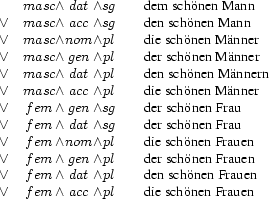15.1.4 Ambiguities versus Disjunction
Much of natural language processing can be understood as solving combinatoric problems. The reason is that natural language is full of ambiguities which one may express by disjunctive logic formulas.
As an example, we consider agreement information for the the German adjective schön (nice). Its inflection schoenen can have be used with a set of possible gender-case-number information. The possibilities can be described by the following propositional formula:
The next question is how to express disjunctive information in a concurrent constraint language such as Oz.
